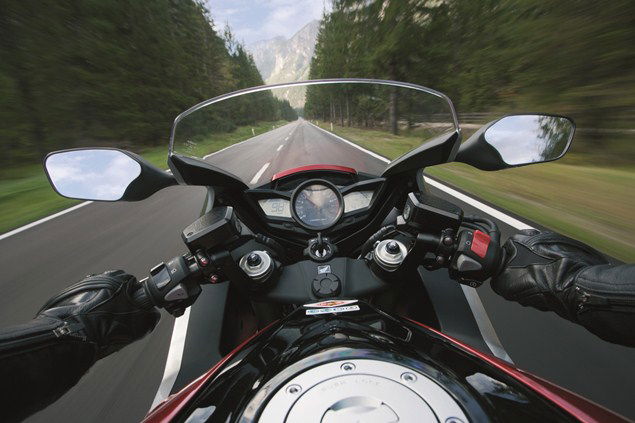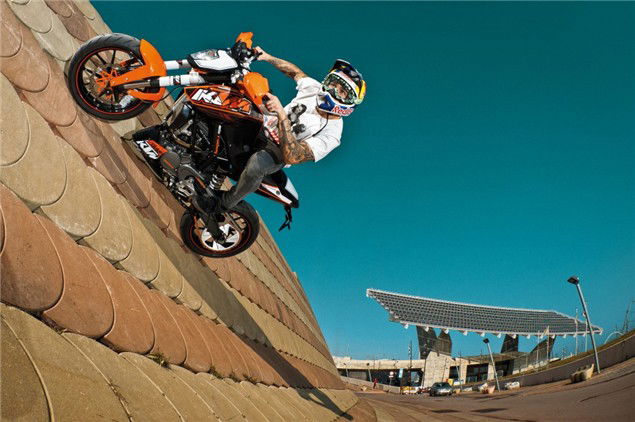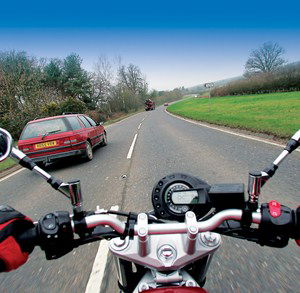Have fun! Five things you can teach yourself
Learn to ride better this weekend


Have fun becoming a better rider
WE’VE mentioned before that just because you’ve passed all your motorcycle tests it doesn’t mean that you have to stop learning. And while some proper post-test training is invaluable there are still plenty of things you can teach yourself that will make you a smoother, better rider.
This stuff isn’t necessarily mentioned in the Highway Code or taught as part of your instruction to get your licence, but know how to do it will make you a more confident, better rider. There’s no magic to any of it, and with a bit of practice you can teach yourself – just make sure you’ve got a clear bit of road.

Silky smooth
1: Smooth gear changes
Clutchless upshifts and blipped downshifts
CHANGING gear smoothly makes an enormous difference to your riding, and once you’ve ‘got’ it you’ll find it’s second-nature. The most important bit is the downshift; a rough one can really unsettle the bike, and since you’re likely to be braking at the same time, that’s a bad thing. Blipping the throttle to match revs is incredibly simple, and takes just a little practice.
If you’re not already blipping, you’re probably slipping the clutch when you change down, letting the speed of the rear wheel drag the engine’s revs up to match the newly-selected cog. Even doing this, you probably already have a pretty good idea of what revs the engine will go to when you select the new ratio. Blipping just eliminates the clutch slip and relies on you to put the engine at just the right speed for the lower gear. Hold the clutch in, and as you drop down a cog tweak the throttle a tad just to bring the revs up to the right level before you release the clutch lever. While practising, it’s a good idea to still slip the clutch a little, in case you’ve got the revs wrong, but soon you’ll get it spot on every time, and simply be able to release the clutch knowing that the change will be smooth. Of course, if you’re slowing down, you’ll want to release the throttle again as you engage the new gear to make sure it doesn’t try to increase or maintain your speed. Don’t worry, it’s simpler than it sounds on paper and you’ll probably have it nailed in just a few minutes.
Clutchless upshifts aren’t so important but they can certainly help. Here it’s simply a case of closing the throttle a fraction at the moment you want to change up and simultaneously nudging the gear lever with your foot. Get it right and, because you’ve closed the throttle and relieved the load on the gears, it will select the next cog just as easily as if you’d used the clutch.

You spin me right round
2: Go slow
Find a car park and practise
YOU might imagine that post-test learning would be all about getting faster, leaning over further and accelerating and braking harder. But actually you can do wonders for your riding when it’s all new by finding a quiet car park and practising your low-speed manoeuvres.
For many riders, their test is the last time they’ll ever really try to ride slowly, or to do something like a turn in the road, but actually practising at low speed can make you much more confident with the weight of a bike as well as giving valuable lessons in throttle, brake and gear control.
You’ve already been taught how to do this stuff, so just make sure that instead of forgetting it now that you’ve passed your test, you get even better at it. Particularly if you’re moving onto a new or bigger bike. And while it might be impressive to carve through a corner with your knee down, your mates will be equally jealous as they see you confidently moving around, feet up, in tight spots while they all paddle furiously and look like they’re going to topple at any minute.

Give watersports a try
3: Raining? Get out on your bike!
FOR many, the moment a dark cloud appears they leave their bike tucked up in the garage and take the car instead. But by getting out in the wet you’ll learn faster than you ever will in the dry.
Now we’re not suggesting you try to go fast or corner hard, although you might be surprised at how much grip you’ve really got. What you’re really doing is gaining confidence and learning to relax and ride smoothly. In the wet, it’s natural that you’ll initially tense-up – holding everything a bit tighter than normal as you try to accelerate, brake and turn more gently. In fact, that tightness is going to make you ride worse.
Relax. Don’t go fast – nobody is standing their with a stopwatch – but just try to loosen up a little. The more wet miles you can pile on, the more confident you’ll get and the better you’ll be able to judge both your own abilities and those of the bike in slippery conditions. The pay off is that you’ll be better in the dry, too.

What's that coming over the hill?
4: Read the road
ONCE you’re on top of all those basics of riding that initially keep your brain working flat out, you’ll find that you’ve got spare mental capacity. The riding bit becomes automatic – so instead of daydreaming about what you might have for dinner or thinking about that important project at work, use the spare brainpower to take more information in from what’s going on around you.
You’ll soon start to notice little things that may never have occurred to you before. Is the road surface worn, for instance? If it is, it might be slippery in places. Are there earth banks at the roadsides? If there are, beware dirt that might have washed onto the asphalt. Was that a gate to a farmer’s field that you just passed? Look out, there’s a good chance there will either be a tractor just around the corner or at least the mud it’s left behind. Even something as seemingly innocent as noticing that the field you’re riding next to has been freshly ploughed should be a glaring clue that there’s a higher-than-average chance that you’ll find mud all over the road just around the corner.
Remember too that the times you choose to get out on your bike and ride on some nice roads are just the same as the ones other people will pick. So if the weather’s good, expect to come across more cyclists, horse riders and walkers than you might usually expect, even if you know the road well.
Basically, however good your riding ability and reactions, a bit of intelligence and thought will still make you better. You can practise reading the road using routes that are familiar already. If you already know the hazards, look out for clues to them that you hadn’t spotted before – there’s a good chance that what you learn will also be applicable to routes you’ve never ridden before.

Now that's just showing off..
5: Remember your level
Not everyone else is as good as you are…
THERE’S one mistake that even the best riders (and drivers, for that matter) often make: they expect others to be as good, or at least as sensible, as they are.
Don’t. It may not be strictly true to suggest that everyone else on the road is an idiot, but having that thought in mind won’t hurt. Read the body language of drivers and see what you can tell from their cars and the way they’re driving. If there are cuddly toys on the parcel shelf and ‘baby on board’ stickers, assume that the driver’s full attention is on dear little Olivia and her latest temper tantrum; he or she probably hasn’t noticed you’re there.
Clues: drivers who think air fresheners or unidentified dangly things hanging from the rearview mirror are more important than a clear view of the road are probably not to be trusted. Expect them to do the unexpected. Sat navs or phones attached to the screen are also the universal language for saying “I am not concentrating on the road or anyone else on it” – consider it a warning.
Is the car in front covered in dents? Think where they came from. Wonder if the driver is a natural. If you come to the conclusion that he’s not, then make sure you leave extra space and be prepared for him to do the unexpected. It’s pretty easy, really.
Remember, righteousness doesn’t make broken bones heal any faster or help repair a damaged bike. On a bike you’ll always come off second best, even if it is the other guy’s fault.

